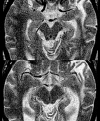Persistent accommodative spasm after severe head trauma
- PMID: 12543762
- PMCID: PMC1771523
- DOI: 10.1136/bjo.87.2.243
Persistent accommodative spasm after severe head trauma
Figures


References
-
- Goldstein JH, Schneekloth BB. Spasm of the near reflex: a spectrum of anomalies. Surv Ophthalmol 1996;40:269–78. - PubMed
-
- Bohlmann BJ, France TD. Persistent accommodative spasm nine years after head trauma. J Clin Neuro-ophthalmol 1987;7:129–34. - PubMed
-
- Bando T, Yamamoto N, Tsukahara N. Cortical neurons related to lens accommodation in posterior lateral suprasylvian area in cats. J Neurophysiol 1984;52:879–91. - PubMed
-
- Hosoba M, Bando T, Tsukahara N. The cerebellar control of accommodation of the eye in the cat. Brain Res 1978;153:495–505. - PubMed
-
- Ohthsuka K, Maekawa H, Takeda M, et al. Accommodation and convergence insufficiency with left middle cerebral artery occlusion. Am J Ophthalmol 1988;106:60–4. - PubMed
Publication types
MeSH terms
LinkOut - more resources
Full Text Sources
Medical
